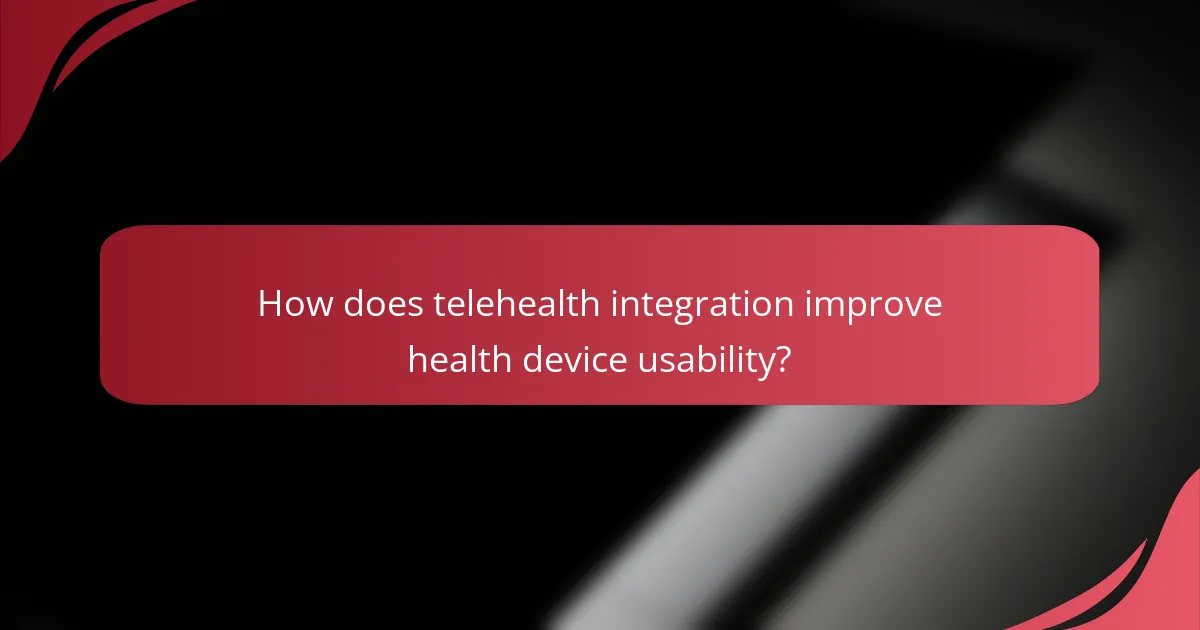Telehealth integration significantly improves the functionality of health devices by fostering real-time communication between patients and healthcare providers. This advancement allows for better monitoring and management of health conditions, ultimately enhancing patient engagement and care. Consumers enjoy increased access to healthcare services, cost savings, and personalized health insights through the use of telehealth-enabled devices.

How does telehealth integration improve health device usability?
Telehealth integration enhances health device usability by enabling seamless communication between patients and healthcare providers, facilitating better monitoring and management of health conditions. This integration allows devices to transmit data in real-time, making it easier for patients to engage with their health and for providers to respond promptly.
Enhanced patient monitoring
Telehealth integration allows for continuous patient monitoring through connected devices, such as wearables and home health equipment. These devices can track vital signs, medication adherence, and other health metrics, providing real-time insights into a patient’s condition.
For instance, a wearable heart monitor can alert both the patient and their healthcare provider if irregular heartbeats are detected, enabling timely intervention. This proactive approach can lead to better health outcomes and reduced hospital visits.
Real-time data sharing
With telehealth integration, health devices can share data instantly with healthcare providers, ensuring that they have access to the most current information. This real-time data sharing helps in making informed decisions regarding treatment plans and adjustments.
For example, a diabetic patient using a continuous glucose monitor can send their glucose levels directly to their doctor, allowing for immediate feedback on dietary or medication changes. This capability enhances the overall management of chronic conditions.
Improved accessibility for remote patients
Telehealth integration significantly improves accessibility for patients living in remote or underserved areas. Health devices can connect patients to healthcare providers without the need for travel, which can be time-consuming and costly.
Patients can use telehealth-enabled devices to consult with specialists from the comfort of their homes, reducing barriers to care. This is particularly beneficial for individuals with mobility issues or those living in rural regions where healthcare facilities are limited.
Streamlined communication with healthcare providers
Telehealth integration streamlines communication between patients and healthcare providers, making it easier to discuss health concerns and treatment plans. Integrated health devices can facilitate messaging and video consultations, enhancing the patient-provider relationship.
For example, a patient can use a health app linked to their device to send messages or schedule virtual appointments with their healthcare team. This direct line of communication fosters a collaborative approach to health management, improving patient satisfaction and adherence to treatment.

What are the key health devices for telehealth?
Key health devices for telehealth include wearable fitness trackers, smart blood pressure monitors, connected glucose meters, and telehealth-enabled stethoscopes. These devices facilitate remote monitoring and data collection, enhancing patient care and engagement.
Wearable fitness trackers
Wearable fitness trackers monitor physical activity, heart rate, and sleep patterns, providing valuable data for both users and healthcare providers. Popular models often sync with mobile apps, allowing users to track their progress and share information with their doctors.
When choosing a fitness tracker, consider battery life, compatibility with other devices, and specific health metrics tracked. Look for devices that are FDA-approved or certified for added reliability.
Smart blood pressure monitors
Smart blood pressure monitors enable users to measure their blood pressure at home and share results with healthcare professionals. These devices typically connect to smartphones via Bluetooth, allowing for easy data tracking and management.
When selecting a monitor, ensure it is validated for accuracy and fits comfortably on your arm. Regular calibration and following manufacturer guidelines are essential for reliable readings.
Connected glucose meters
Connected glucose meters provide real-time blood sugar readings and can transmit data to healthcare providers for better diabetes management. Many models offer features like reminders for testing and insights based on historical data.
Choose a glucose meter that is easy to use and has a user-friendly app. Check if it integrates with other health management tools to streamline your diabetes care.
Telehealth-enabled stethoscopes
Telehealth-enabled stethoscopes allow healthcare providers to conduct remote examinations by transmitting heart and lung sounds to specialists. These devices enhance telehealth consultations by providing critical auditory data without the need for in-person visits.
When considering a stethoscope, look for features like noise cancellation and high-quality audio transmission. Ensure it complies with relevant health regulations to maintain patient confidentiality and data security.

How do consumers benefit from telehealth-enabled devices?
Consumers benefit from telehealth-enabled devices by gaining easier access to healthcare services, reducing costs, and receiving personalized health insights. These devices facilitate remote consultations and monitoring, making healthcare more efficient and tailored to individual needs.
Increased convenience
Telehealth-enabled devices allow consumers to access healthcare from the comfort of their homes, eliminating the need for travel and long wait times. Patients can schedule appointments at their convenience, often leading to quicker responses from healthcare providers.
This convenience is particularly beneficial for individuals with mobility issues or those living in remote areas, as it ensures they receive timely medical attention without the barriers of distance or transportation.
Cost savings on healthcare
Using telehealth-enabled devices can lead to significant cost savings for consumers. Remote consultations typically cost less than in-person visits, and patients can avoid expenses related to travel and time off work.
Additionally, these devices can help prevent costly emergency room visits by allowing for early intervention and ongoing management of chronic conditions, which can ultimately lead to lower overall healthcare costs.
Improved health outcomes
Telehealth-enabled devices contribute to improved health outcomes by facilitating regular monitoring and timely interventions. Patients can track vital signs and symptoms, allowing healthcare providers to make informed decisions based on real-time data.
Studies have shown that consistent monitoring through these devices can lead to better management of chronic conditions, reducing hospitalizations and enhancing overall patient health.
Personalized health insights
Telehealth devices often provide personalized health insights based on individual data, helping consumers understand their health better. This can include tailored recommendations for lifestyle changes, medication adjustments, or preventive measures.
By leveraging data analytics, these devices can offer insights that are specific to a patient’s unique health profile, empowering them to take proactive steps in managing their health effectively.

What are the challenges of telehealth integration?
Telehealth integration faces several challenges that can hinder its effectiveness and adoption. Key issues include data privacy concerns, technology adoption barriers, and interoperability problems that affect the seamless exchange of health information.
Data privacy concerns
Data privacy is a significant challenge in telehealth integration, as sensitive patient information is transmitted over digital platforms. Healthcare providers must comply with regulations like HIPAA in the U.S. to ensure that patient data is protected from breaches.
To mitigate risks, organizations should implement strong encryption methods and conduct regular security audits. Patients should also be educated about their rights regarding data privacy and how their information is used.
Technology adoption barriers
Many healthcare providers face technology adoption barriers that limit telehealth integration. These barriers can include high costs of technology, lack of training, and resistance to change among staff.
To overcome these obstacles, healthcare organizations can invest in user-friendly platforms and provide comprehensive training for staff. Additionally, offering incentives for adopting telehealth solutions can encourage wider acceptance.
Interoperability issues
Interoperability issues arise when different telehealth systems cannot communicate effectively with each other. This can lead to fragmented patient care and incomplete health records, making it difficult for providers to deliver comprehensive services.
To address interoperability challenges, healthcare organizations should adopt standardized protocols and invest in compatible systems. Collaborating with technology vendors to ensure that their solutions can integrate with existing electronic health record (EHR) systems is also crucial.

How to choose the right telehealth device?
Choosing the right telehealth device involves assessing compatibility with your current systems, ensuring ease of use, and evaluating data security features. These factors will help you select a device that meets your healthcare needs while providing a seamless experience.
Evaluate compatibility with existing systems
When selecting a telehealth device, check its compatibility with your existing healthcare systems, such as electronic health records (EHR) and practice management software. Devices that easily integrate with these systems can streamline workflows and reduce administrative burdens.
Look for devices that support common standards like HL7 or FHIR, as these facilitate data exchange. Additionally, consider whether the device can connect with other telehealth platforms you may be using, ensuring a cohesive experience for both providers and patients.
Consider user-friendliness
User-friendliness is crucial for both healthcare providers and patients. A device that is intuitive and easy to navigate can enhance engagement and compliance. Features such as clear displays, simple controls, and straightforward setup processes are essential.
Test devices with potential users to gather feedback on their experience. Consider factors like screen size, touch responsiveness, and the availability of customer support. A user-friendly device can significantly improve the telehealth experience, especially for older adults or those less tech-savvy.
Assess data security features
Data security is paramount in telehealth, as sensitive patient information is transmitted electronically. Ensure that the device complies with relevant regulations, such as HIPAA in the United States, to protect patient privacy and confidentiality.
Look for features such as end-to-end encryption, secure user authentication, and regular software updates. Additionally, consider devices that offer audit trails to monitor access and usage, as this can help identify potential security breaches and maintain compliance with legal standards.


